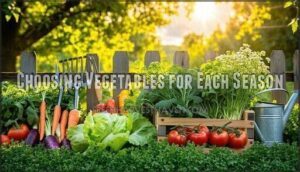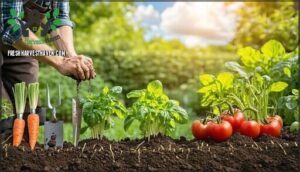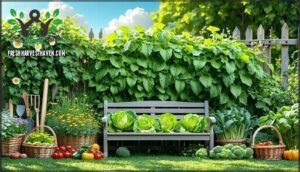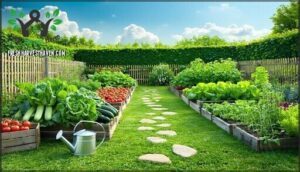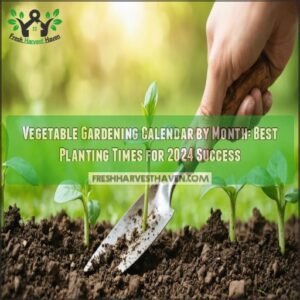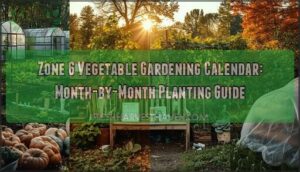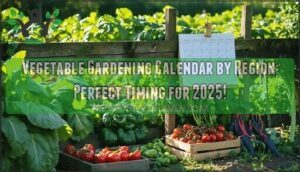This site is supported by our readers. We may earn a commission, at no cost to you, if you purchase through links.
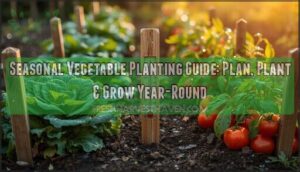
Seasonal vegetable planting guides match your crops to your climate’s natural rhythms, turning your garden into a year-round producer instead of a summer-only project. Once you understand the difference between cool-season and warm-season crops, you’ll know exactly what to plant when frost threatens and when the soil warms up.
Table Of Contents
- Key Takeaways
- Planning Your Seasonal Vegetable Garden
- Choosing Vegetables for Each Season
- Planting Calendars and Timing by Region
- Step-by-Step Planting and Sowing Guide
- Maintaining a Healthy and Productive Garden
- Frequently Asked Questions (FAQs)
- What vegetables to plant in what month?
- In what order should I plant my vegetable garden?
- What vegetables can and cannot be planted next to each other?
- What vegetable is best planted all year round?
- How to stagger vegetable plantings?
- How often should I water new seedlings?
- When should I harvest lettuce varieties?
- Do vegetables need specific soil pH levels?
- How to extend harvest with succession planting?
- Which vegetables tolerate partial shade conditions?
- Conclusion
Key Takeaways
- Plant cool-season vegetables like lettuce, peas, and broccoli in early spring and fall when temperatures stay between 40-70°F, then switch to warm-season crops like tomatoes and peppers once soil warms to 60°F and frost danger passes.
- Use your ZIP code and USDA Hardiness Zone to find exact planting dates for your area, since timing windows shift by weeks between zones and local frost patterns determine when you can safely plant each crop.
- Practice crop rotation and companion planting to cut soil-borne diseases by 40-60%, boost yields up to 32%, and reduce your need for synthetic fertilizers while naturally controlling pests.
- Start succession planting by sowing small batches of fast-growing crops every 10-14 days instead of planting everything at once, which gives you continuous harvests throughout the season rather than overwhelming gluts.
Planning Your Seasonal Vegetable Garden
Before you plant your first seed, you need to set yourself up for success. The right location, proper layout, and healthy soil form the foundation of any productive vegetable garden.
Here’s what you need to think about before breaking ground.
Choosing The Right Garden Location
Before you break ground, pick a spot that checks all the boxes—your vegetables will thank you with a better harvest and fewer headaches down the road. Aim for six to eight hours of direct sunlight exposure daily, and make sure soil drainage is solid—standing water kills roots fast. Wind protection matters too, especially for young plants.
Check soil quality before planting, and consider your garden layout for easy access. Choosing the right location sets everything else up for success.
Selecting Plot Size and Layout
Once you’ve got the right spot picked out, it’s time to figure out how much space you actually need and how to organize it. Start small if you’re new—a 4×8-foot plot is plenty for beginners and keeps maintenance manageable. Your garden size depends on what you want to grow and how much time you can commit.
- Sketch your layout design before digging to improve garden space and prevent overcrowding
- Use a garden planning tool to map beds, pathways, and plant selection by sun exposure
- Improve your yard with raised beds or containers if soil quality or drainage is poor
Soil Preparation and Improvement
Your layout’s in place—now the real foundation work begins: improving the soil to give your plants everything they need to thrive. Start with soil testing to check pH balancing and nutrient levels. Mix in organic compost to boost soil health and improve structure. Mulch benefits include moisture retention and temperature regulation. Choose fertilizer options based on your test results, and monitor soil temperature before planting for ideal germination.
| Soil Preparation Task | Best Timing | Key Benefit |
|---|---|---|
| Compost making and adding | Fall or early spring | Enriches nutrients, improves drainage |
| pH adjustment with lime/sulfur | 2-3 months before planting | Optimizes nutrient availability |
| Mulching beds | After planting or transplanting | Soil conservation, weed suppression |
Choosing Vegetables for Each Season
Not all vegetables thrive in the same conditions—some love the crisp air of spring, while others need summer’s heat to flourish. Picking the right crops for each season sets you up for a steady harvest all year long.
Picking the right crops for each season sets you up for a steady harvest all year long
Here’s how to match vegetables to the seasons, rotate your crops wisely, and choose varieties that work for your skill level.
Cool-Season Vs. Warm-Season Vegetables
Not all vegetables march to the same seasonal drumbeat—some thrive in frosty mornings, while others demand summer’s heat. Cool-season vegetables like lettuce, broccoli, and peas flourish in temperatures between 40-70°F, while warm-season crops such as tomatoes, peppers, and squash need 70-85°F to produce.
Understanding this vegetable classification helps you plan your planting guide and optimize your seasonal harvest through effective crop rotation in your vegetable garden.
Selecting Suitable Vegetable Varieties
The right seed selection can make or break your seasonal harvest, with adapted varieties yielding up to 40% more than mismatched choices. Your vegetable variety selection should balance climate adaptation, disease resistance, and your growing conditions for true yield optimization.
- Disease-resistant varieties boost harvestable yields by 15-40% under pressure and reduce crop loss risk markedly
- Regional adaptation matters—choosing seed varieties matched to your precipitation and heat units improves success rates by 27%
- Hybrid vs. heirloom: Hybrids offer uniformity and 33% longer shelf life; heirlooms deliver excellent flavor and genetic diversity
- Days to maturity guides your planting guide timing, ranging from 50 days (lettuce) to 120 days (pumpkin) in most zones
Understanding the importance of vegetable varieties is essential for a successful garden.
Crop Rotation and Companion Planting
By planting your vegetable planting guide with crop rotation and companion planting, you’ll unleash pest control and soil enrichment benefits that monoculture can’t match. Crop diversity through rotation slashes soil-borne pathogens by 40–60%, while polyculture benefits include up to 32% higher yields. Garden planning with these ecosystem services builds resilience into your planting schedule. Implementing a crop rotation plan can markedly improve soil health and reduce the need for synthetic fertilizers.
| Crop Rotation Strategy | Companion Planting Pair | Key Benefit |
|---|---|---|
| Legumes → Heavy Feeders | Marigolds + Kale | 200 lbs nitrogen/acre; cuts aphids |
| Leafy Greens → Root Crops | Onions + Tomatoes | Breaks pest cycles; stops wilt |
| Brassicas → Fruiting Plants | Purslane + Strawberries | Reduces pathogens 40%; boosts fruit |
| Cover Crops → Summer Veg | Basil + Peppers | Enriches soil; attracts pollinators |
| Root Vegetables → Legumes | Carrots + Peas | Improves structure; fixes nitrogen |
Rotating through four or more crop families strengthens pollination and soil structure while dramatically cutting fertilizer needs.
Tips for Beginners and Advanced Gardeners
Whether you’re starting your first seedling tray or fine-tuning a decade-old garden system, matching your skill level to the right techniques can mean the difference between a thriving harvest and a frustrating season. Here’s how to match your vegetable planting guide to your experience:
- Beginners: Start with basic gardening tools, follow seed packet information closely, and use a planting calendar by zip code to time sowings.
- Intermediate: Add soil testing and compost making to boost nutrients while experimenting with garden design layouts.
- Experienced: Implement crop monitoring systems and perfect beginner gardening tips into custom schedules.
- All Levels: Keep learning—even pros discover new gardening tips each season.
Planting Calendars and Timing by Region
Getting your timing right makes all the difference between a thriving garden and a frustrating guessing game. The trick is knowing when your soil is ready and which crops can tolerate your local conditions.
Here’s how to dial in your planting schedule using calendars, hardiness zones, and regional frost patterns.
Using Planting Calendars by ZIP Code
Your local ZIP code is the key that unlocks a planting calendar custom-fit to your exact growing conditions—down to the week, sometimes even the day.
Tailored planting calendars pull in local weather patterns, climate zones, and regional gardening data to give you spring planting dates and fall planting dates that actually match what’s happening outside your door.
It’s seasonal planning made simple, so you’re not guessing when to plant based on someone else’s location.
Understanding USDA Hardiness Zones
Think of USDA Hardiness Zones as climate neighborhoods—each one tells you which plants can survive winter in your area based on average minimum temperatures. The zones divide North America into 13 regions based on 10°F temperature differences, helping you match vegetables to your local climate.
Here’s what hardiness zones reveal:
- Zone classification ranges from Zone 1 (coldest) to Zone 13 (warmest), with subzones (a and b) for precision
- Climate mapping shows geographic variations—Zone 7a winters hit 0-5°F, while Zone 8b stays milder at 15-20°F
- Frost date considerations shift by weeks between zones, directly affecting your spring and fall planting windows
- Plant hardiness levels determine which crops thrive—kale survives Zone 3, but peppers need Zone 5 or warmer
Gardening by location starts here.
Regional Planting Dates (Zones 7a–8b)
Zones 7a through 8b enjoy extended growing seasons that let you plant nearly year-round with smart timing. In Zone 7a, your last spring frost usually arrives mid-April, while Zone 8b gardeners often finish with frost by late March. Cool-season crops like lettuce and peas go in the ground 4-6 weeks before these dates. Warm-season vegetables—tomatoes, peppers, squash—wait until soil warms to 60°F, usually mid-April through early May.
Fall planting dates reverse the calendar: start cool-season crops in August for Zone 7a, early September for Zone 8b. Regional weather patterns and local plant varieties matter, so check your specific frost date management through USDA Plant Hardiness Zones and adjust your planting guide accordingly. Seasonal crop planning and zone-specific gardening turn these windows into harvests.
Frost Dates and Growing Season Management
Knowing when to expect your first and last frost turns guesswork into a reliable game plan. Record your last spring frost and first fall frost to calculate your growing season length—those days to harvest matter when choosing varieties.
Frost tolerance separates what survives from what dies, so match crops to your growing windows.
Climate shift and changing weather patterns mean checking local frost dates yearly keeps your season length predictions accurate.
Step-by-Step Planting and Sowing Guide
Getting your seeds and seedlings into the ground the right way makes all the difference between a struggling garden and one that thrives from day one. The method you choose—whether starting from seed or using transplants—depends on what you’re growing and when.
Let’s walk through the practical steps that’ll set you up for success across all four seasons.
Direct Sowing Vs. Transplanting Seedlings
Some gardeners swear by dropping seeds straight into the ground, while others won’t plant a thing until it’s already sprouted indoors—and honestly, both camps have it right depending on what you’re growing. Direct seeding works beautifully for carrots, beans, and radishes that hate transplant shock, while seedling care and transplanting gives you a head start with tomatoes and peppers.
Match your seed starting method to each crop’s personality, prep your soil properly, and you’ll nail planting depth either way.
Seed Packet Information and Techniques
That seed packet in your hand isn’t just colorful packaging—it’s a tiny instruction manual loaded with planting dates, spacing requirements, and days-to-harvest counts that can make or break your growing season. Read packet labels carefully to match seed varieties with your zone, note sowing depths (usually two to three times the seed’s width), and check germination rates before seed starting.
Proper seed storage in a cool, dry spot keeps your seed selection viable for next year’s transplanting seedlings.
Planting Spring, Summer, Fall, and Winter Crops
Once you know how to read those packets, the real fun begins—matching the right crops to each season’s rhythm so you’re harvesting something delicious every month of the year.
Spring planting dates kick off with cold-hardy lettuce and peas, while summer brings heat-loving tomatoes and peppers.
Fall planting dates usher in broccoli and kale, and winter gardening in milder climate zones can yield carrots and spinach, making crop rotation and garden planning essential for year-round seasonal harvest success.
Herb and Flower Planting Tips
Herbs and edible flowers don’t just fill in the gaps between your vegetables—they’re the secret weapon that turns a productive garden into one that smells amazing, attracts pollinators, and keeps pests guessing. Fragrant herbs like basil and cilantro thrive with warm soil temperature, while flowers boost your herb garden’s appeal:
- Plant combinations matter—pair marigolds with tomatoes for natural pest control
- Match planting depth to seed size—tiny flower seeds need light exposure
- Time blossom care with herb planting tips for synchronized flower arrangements and harvests
Maintaining a Healthy and Productive Garden
Getting your plants in the ground is only the beginning. Your garden needs consistent care to stay healthy and produce a steady harvest throughout the season.
Here’s how to keep your vegetable garden thriving from planting day through the final harvest.
Watering, Fertilizing, and Soil Health
Your garden’s long-term success hinges on three cornerstones: consistent watering, balanced feeding, and living soil that works as hard as you do. Check soil moisture before watering—most vegetables need 1-2 inches weekly.
Conduct soil testing annually to guide fertilizer application. Choose fertilizer types based on plant needs, and practice compost management to build nutrient-rich soil.
Monitor soil temperature for ideal planting, use water conservation techniques like mulching, and prioritize soil preparation and conservation for seasons ahead.
Pest and Disease Management
Vigilance is your best defense against garden threats. Inspect plants weekly for early signs of trouble—yellowing leaves, chewed foliage, or unusual spots signal problems that spread fast if ignored.
Effective pest and disease management relies on:
- Physical barriers like row covers to block insects before they strike
- Crop monitoring twice weekly to catch aphids, caterpillars, or fungal issues early
- Biological solutions such as ladybugs and nematodes for natural pest control
- Organic methods including neem oil sprays and companion planting for disease prevention
Remove infected plants immediately to stop contamination.
Sustainable and Organic Gardening Practices
Building a thriving garden doesn’t mean sacrificing the planet—sustainable choices actually make your soil richer and your harvests more abundant. Compost recycling feeds your beds naturally, while organic pest control methods like companion planting keep harmful chemicals at bay.
Eco-friendly tools that last for years reduce waste, and sustainable irrigation systems conserve water, ensuring your garden thrives without depleting resources.
Soil conservation techniques protect what you’ve built, making organic gardening both practical and rewarding.
Harvest Planning and Seasonal Maintenance
Timing your harvest right—and keeping your garden tidy between seasons—turns a good growing year into a great one. Harvest scheduling means picking vegetables at peak ripeness for better crop yield management. Seasonal pruning removes spent plants and readies beds for the next growing season management cycle.
- Check garden recordkeeping notes to track harvest time patterns
- Use crop harvest planning to stagger plantings and extend your harvesting window
- Practice soil conservation by adding compost after each seasonal gardening phase
- Monitor daily—vegetables can go from perfect to overripe fast
Frequently Asked Questions (FAQs)
What vegetables to plant in what month?
Plant cool-season crops like lettuce, peas, and broccoli in early spring (March–April). Fall brings another cool-season window (August–September) for carrots, kale, spinach.
In May–June, shift to warm-season favorites—tomatoes, peppers, cucumbers.
Monthly planting dates shift with your zone, so check local frost schedules for ideal planting times and seasonal harvest success.
In what order should I plant my vegetable garden?
Start cool-season crops first in early spring, then shift to warm-season vegetables after the last frost.
Your planting schedule depends on crop prioritization, soil preparation, and regional planting dates for effective garden planning.
What vegetables can and cannot be planted next to each other?
Birds of a feather flock together—and in your garden, the right vegetable pairings can make all the difference. Companion planting techniques help you match compatible crops while avoiding bad neighbors. For instance, tomatoes thrive near basil but struggle beside brassicas.
Smart garden planning and crop rotation guarantee soil compatibility and healthier vegetable varieties.
What vegetable is best planted all year round?
Lettuce and leafy greens are your best bet for year-round vegetables, since you can plant cool-season varieties in spring and fall, and warm-season types in summer.
With successive planting dates and proper garden planning, you’ll enjoy a continuous harvest through vegetable rotation.
How to stagger vegetable plantings?
Staggered succession planting transforms your garden into a nonstop harvest machine. Sow small batches every two weeks instead of planting everything at once. This keeps crops at different growth stages, so you’ll harvest continuously rather than facing a mountain of zucchini all at once.
How often should I water new seedlings?
New transplant seedlings need consistent soil moisture—check daily and water when the top inch feels dry.
Keep the soil damp but never soggy, as overwatering drowns roots and invites disease.
When should I harvest lettuce varieties?
Most lettuce varieties reach maturity 30 to 70 days after planting, depending on the type.
Harvest when leaves are firm and crisp, ideally in the morning for best flavor and texture.
Pick outer leaves first or cut the entire head at soil level.
Do vegetables need specific soil pH levels?
Yes, most vegetables need specific soil pH levels to thrive. Testing reveals whether your soil is acidic or alkaline, which affects nutrient availability.
Proper pH levels support healthy growth and help your fertilizer management work efficiently for your vegetable garden.
How to extend harvest with succession planting?
Honestly, who has the time to replant lettuce every week like some obsessed gardener? You do—if you want non-stop harvests.
Succession planting means sowing small batches every 10–14 days for continuous harvesting, maximizing crop rotation and seasonal sowing without gaps.
Which vegetables tolerate partial shade conditions?
Leafy greens like lettuce, spinach, and kale thrive in partial shade, along with cool-season vegetables such as peas, broccoli, and radishes.
These shade-tolerant crops actually prefer low light conditions during warmer months, making them perfect for shade gardening and smart garden planning.
Conclusion
Funny how most gardeners wait until spring to think about planting, when smart growers already harvested cool-season crops weeks earlier. You don’t need more space or better weather—you need seasonal vegetable planting guides that tell you exactly what thrives in each window.
Stop fighting your climate’s rhythm and start riding it instead. Plant radishes when tomatoes fail, grow kale through winter, and watch your garden produce food every single month. The calendar doesn’t limit you—it multiplies your harvests once you learn to read it.
- https://extension.usu.edu/yardandgarden/research/suggested-vegetable-planting-dates-for-utah
- https://waynehighlands.com/planting-vegetables-according-to-seasonal-and-climate-conditions/
- https://www.pubs.ext.vt.edu/426/426-331/426-331.html
- https://www.gardeningchannel.com/vegetable-planting-calendar-by-season/
- https://farmingshelter.com/seasonal-planting-guide-growing-the-right-crops-at-the-right-time/

